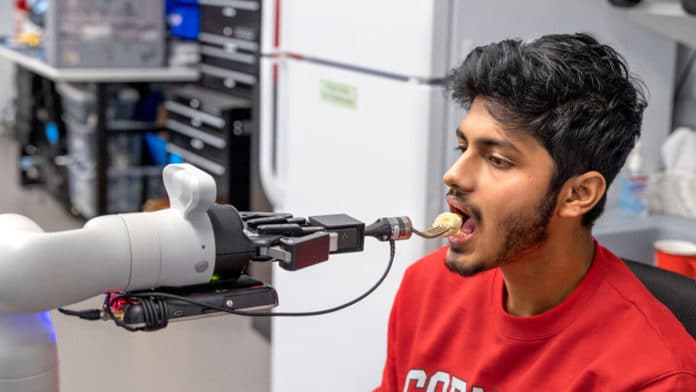Robots could become a crucial caregiver in the future, with new technologies constantly being developed to help improve the quality of life of the world’s aging population and people with physical disabilities.
Cornell University scientist Tapomayukh Bhattacharjee is developing assistive robotic arms to help feed people with physical disabilities and mobility limitations. Bhattacharjee believes that robots have the potential to transform caregiving and that eating is one of the key areas where they could provide an assistive robotic hand.
He has recently received a four-year, $1.5 million grant from the National Science Foundation’s National Robotics Initiative to help him and his EmPRISE Lab develop assistive robotics. The project aims to address the way people with mobility issues are given a chance for improved control and independence over their environments, especially how they are fed.
“Despite great strides taken toward sustainable solutions in controlled environments,” he wrote in his grant proposal, “robots are far from ready for adoption in real-home environments as long-term caregiving solutions.”
To address the eating challenge, Bhattacharjee and his team are working on developing machine learning algorithms that learn by obtaining human feedback to perform difficult tasks related to eating, particularly with different forms of food. The goal is to develop safe and learning algorithms for bite transfer – that is, the robot actually placing the food safely in a person’s mouth.
Over time, these active learning algorithms will help robotic hands capture users’ preferences, making it easier for the machines to do that job.
“The main lesson we learned in our experiments was that every user is different,” he said. “Everybody has their personal preferences. And if we really want a long-term caregiving solution, the solution needs to be personalized to the user. And just like a patient and a caregiver need time to get used to each other, it’s the same with a patient and a robot.”
With his assistive technology, Bhattacharjee is mainly focusing on people with spinal cord injuries – those who are limited physically but not necessarily cognitively, so they would be able to help train the robot. Also, the team will leverage the idea of human feedback, specifically by embracing the inevitable physical contact between the robot and humans. The grant period starts Jan. 1, 2022, and runs through 2025.
